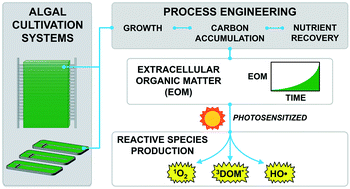当前位置:
X-MOL 学术
›
Environ. Sci.: Water Res. Technol.
›
论文详情
Our official English website, www.x-mol.net, welcomes your feedback! (Note: you will need to create a separate account there.)
Impact of growth phases on photochemically produced reactive species in the extracellular matrix of algal cultivation systems
Environmental Science: Water Research & Technology ( IF 5 ) Pub Date : 2017-09-01 00:00:00 , DOI: 10.1039/c7ew00172j Raul Tenorio 1, 1, 2, 3, 4 , Anna C. Fedders 1, 2, 3, 4 , Timothy J. Strathmann 1, 4, 5, 6 , Jeremy S. Guest 1, 2, 3, 4
Environmental Science: Water Research & Technology ( IF 5 ) Pub Date : 2017-09-01 00:00:00 , DOI: 10.1039/c7ew00172j Raul Tenorio 1, 1, 2, 3, 4 , Anna C. Fedders 1, 2, 3, 4 , Timothy J. Strathmann 1, 4, 5, 6 , Jeremy S. Guest 1, 2, 3, 4
Affiliation

|
There is growing interest in microalgal biotechnologies for biofuel production and nutrient recovery in wastewater treatment. Often overlooked is the exudation of extracellular organic matter (EOM) in algal reactors and its influence on dissolved organic carbon (DOC) characteristics and photochemical processes. This study reports photosensitized production of excited triplet state dissolved organic matter (3DOM*), hydroxyl radicals (HO˙), and singlet oxygen (1O2) under simulated sunlight in photobioreactor extracellular matrices. Reactive species were measured in irradiated supernatant from batch cultures of Chlamydomonas reinhardtii throughout lag (1.2–1.9 mg-C L−1 as DOCEOM), exponential (1.9–8.1 mg-C L−1), early stationary (carbon accumulation; 8.1–21.4 mg-C L−1), and late stationary (21.4–108 mg-C L−1) growth phases, and in solutions amended with Suwannee river natural organic matter (SRNOM) as a benchmark. DOCEOM represented 1.0–8.6% of fixed carbon (cellular organic carbon + EOM) across algal phases of growth. EOM solutions exhibited lower light absorption and reactive species production than SRNOM solutions per mg-C L−1. However, photosensitized 3DOM* quantum yield coefficients in EOM solutions during all growth phases and HO˙ apparent quantum yields observed during exponential and early stationary phases were greater than in SRNOM solutions. Additionally, 1O2 apparent quantum yields in EOM solutions during exponential and late stationary phases were similar to SRNOM solutions. EOM solutions also photoproduced reactive species at levels comparable to natural waters. These results suggest sensitized photochemical processes involving EOM and growth medium constituents may contribute to DOM bleaching and mineralization, nutrient cycling, pathogen inactivation, and fate of trace organic contaminants in engineered algal systems.
中文翻译:

生长期对藻类培养系统细胞外基质中光化学产生的反应性物种的影响
对于用于废水处理中的生物燃料生产和养分回收的微藻生物技术,人们越来越感兴趣。藻类反应器中细胞外有机物(EOM)的渗出及其对溶解有机碳(DOC)特性和光化学过程的影响通常被忽略。这项研究报告了在光生物反应器细胞外基质在模拟阳光下光敏化生产激发态三重态溶解有机物(3 DOM *),羟基自由基(HO˙)和单线态氧(1 O 2)。在整个滞后期间,对莱茵衣藻分批培养物的辐照上清液中的反应性物种进行了测量(DOC EOM为1.2–1.9 mg-C L -1)),指数(1.9–8.1 mg-C L -1),早期稳定(碳积累; 8.1–21.4 mg-C L -1)和晚期稳定(21.4–108 mg-C L -1)生长期,以及在以Suwannee河天然有机物(SRNOM)为基准进行修改的解决方案中。DOC EOM代表藻类生长各阶段固定碳的1.0–8.6%(细胞有机碳+ EOM)。与SRNOM溶液每mg-C L -1相比,EOM溶液显示出较低的光吸收和反应物种产生。但是,光敏3在EOM溶液中所有生长阶段的DOM *量子产率系数以及在指数期和早期固定阶段观察到的HO˙表观量子产率均大于SRNOM溶液。此外,EOM溶液在指数相和后期固定相期间的1 O 2表观量子产率与SRNOM溶液相似。EOM解决方案还可以以与天然水相当的水平光生反应性物种。这些结果表明,涉及EOM和生长培养基成分的敏化光化学过程可能有助于DOM漂白和矿化,养分循环,病原体失活以及工程藻类系统中微量有机污染物的命运。
更新日期:2017-09-04
中文翻译:

生长期对藻类培养系统细胞外基质中光化学产生的反应性物种的影响
对于用于废水处理中的生物燃料生产和养分回收的微藻生物技术,人们越来越感兴趣。藻类反应器中细胞外有机物(EOM)的渗出及其对溶解有机碳(DOC)特性和光化学过程的影响通常被忽略。这项研究报告了在光生物反应器细胞外基质在模拟阳光下光敏化生产激发态三重态溶解有机物(3 DOM *),羟基自由基(HO˙)和单线态氧(1 O 2)。在整个滞后期间,对莱茵衣藻分批培养物的辐照上清液中的反应性物种进行了测量(DOC EOM为1.2–1.9 mg-C L -1)),指数(1.9–8.1 mg-C L -1),早期稳定(碳积累; 8.1–21.4 mg-C L -1)和晚期稳定(21.4–108 mg-C L -1)生长期,以及在以Suwannee河天然有机物(SRNOM)为基准进行修改的解决方案中。DOC EOM代表藻类生长各阶段固定碳的1.0–8.6%(细胞有机碳+ EOM)。与SRNOM溶液每mg-C L -1相比,EOM溶液显示出较低的光吸收和反应物种产生。但是,光敏3在EOM溶液中所有生长阶段的DOM *量子产率系数以及在指数期和早期固定阶段观察到的HO˙表观量子产率均大于SRNOM溶液。此外,EOM溶液在指数相和后期固定相期间的1 O 2表观量子产率与SRNOM溶液相似。EOM解决方案还可以以与天然水相当的水平光生反应性物种。这些结果表明,涉及EOM和生长培养基成分的敏化光化学过程可能有助于DOM漂白和矿化,养分循环,病原体失活以及工程藻类系统中微量有机污染物的命运。


























 京公网安备 11010802027423号
京公网安备 11010802027423号